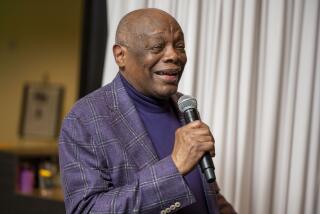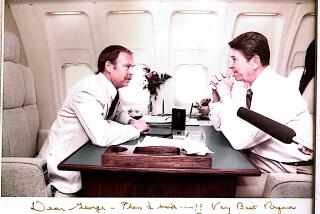An Appreciation: Huell Howser, the great adventurer
Huell Howser, a great man of television, died late Sunday in Palm Springs, to which he retired quietly late last year — or as quietly as an interested public would let him, the announcement that he would make no more programs being news throughout the state and prompting tributes and some expressions of concern that now will be multiplied many times over. He was a boyish 67 years old.
If you lived in California in the last few decades and owned a television you likely have an opinion, and quite possibly do an imitation, of Howser, and it probably involves the phrase “That’s amazing!” With his healthy glow, broad shoulders and Marine-trained bearing, his melodious Tennessee accent and hound-friendly demeanor, he cut a big figure on the small screen.
Under the banners of his several public-television series, including “Videolog,” “California’s Gold,” “California’s Green,” “Downtown,” “Road Trip” and “Visiting,” Howser roamed the city and the state, its parks and diners, factories and museums and mom-and-pop shops. He created a moving-picture library of this place in that time: its common spaces, its secret corners, its many colors.
PHOTOS: Huell Howser’s career in pictures
It will be a gift to the graduate students of future centuries, when they come to write their dissertations on life in ours. But even as a chronicler of the present day, his interests ran more to those things long-lived and burnished by tradition than to the trendy or new-fangled.
As a reporter, Hollywood-style celebrity did not interest him; but he was a celebrity himself, in a humble, Huell Howser-ish way. He has been worked into episodes of “Weeds” and “The Simpsons.” A ham and pineapple cheeseburger in Yermo, a double chili cheese dog at Pink’s and a doughnut at Stan’s in Westwood all have borne his name.
Howser, who arrived in Los Angeles from Nashville by way of New York in 1981, was often compared to TV’s other great chronicler of Southern California, Ralph Story, whose “Ralph Story’s Los Angeles” was a feature of KNXT (now KCBS) through the 1960s. (Howser spent his first five years here working for that station, before setting himself up as a self-producing independent contractor, working out of KCET.)
But where Story was a historian, a creator of short documentaries rich with research and archival material, Howser was, in the best sense, a tourist — “adventurer” is the more apt word — who had read just enough of the guidebook to know what he wanted to see, but not so much as to make the trip redundant. He went into a room with things left to learn, so that he and you learned them together.
“If I already know what’s behind the door I can’t be surprised when we open it,” he told me once. Watching his reports, even years later, you are put into the moment, you are living in the Now.
Plenty of people got him wrong. They saw him only as comical, a hick in the city; they mistook his straightforward approach for simplicity and his sincerity for simpleness.
Nothing could have been further from the truth. Howser had a clear and subtle vision of what he wanted and how to get it.
PHOTOS: Huell Howser’s career in pictures
Using a hand-held microphone, he said, “allows me to put my hand on your shoulder and talk to you, whereas a [clip-on microphone] disconnects you from a person and makes it more of a television show. ‘You’ve got to stand right over here, move 2 inches this way, and look in the camera — testing one, two, one, two.’ By the time you do all that it’s gone.”
He liked long takes shot wide enough to let the eye wander around in the frame, drinking in details — Luis Fuerte and then Cameron Tucker were his cameramen — and to let conversations other reporters might have reduced to a few sound bites run on at length.
Nobody — really, nobody — worked the way he did. Raising his own money, keeping his overhead low and making his series free to California’s PBS affiliates, he created a low-overhead, take-it-or-leave-it model that let him do things his way until the day he quit.
We lived for years in the same neighborhood; I would see him on the street — it’s the sort of neighborhood where you do see people on the street — often surrounded by admirers with a question to ask, a memory to share or a subject to suggest. After I profiled him for The Times in 2009, we continued to meet for breakfast once in a while.
The private Howser was a little more modulated than on TV, of course. He was gregarious and forthcoming and thoughtful, yet also private — that mix of openness and circumspection that is perhaps as much a vestige of his Southern roots as was his accent. Nothing he said ever sounded like small talk: It’s not that we discussed weighty matters necessarily, though sometimes we did, just that he gave little things their due.
“You could tell me that I couldn’t go outside of a five-mile radius from where we’re having breakfast right now for stories and I wouldn’t blink an eye,” he told me, back in 2009. “There’s enough right within five miles to keep me busy the rest of my life.”
The stories will have to get along without him now.
PHOTOS, VIDEOS & MORE:
GRAPHIC: Faces to watch in 2013
PHOTOS: 15 shocking moments from ‘South Park’
PHOTOS: Best TV of 2012
More to Read
The complete guide to home viewing
Get Screen Gab for everything about the TV shows and streaming movies everyone’s talking about.
You may occasionally receive promotional content from the Los Angeles Times.







